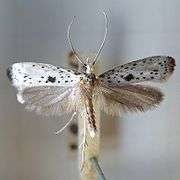Yponomeuta plumbella
| Yponomeuta plumbella | |
|---|---|
| Moth of Yponomeuta plumbella | |
| Scientific classification | |
| Kingdom: | Animalia |
| Phylum: | Euarthropoda |
| Class: | Insecta |
| Order: | Lepidoptera |
| Family: | Yponomeutidae |
| Genus: | Yponomeuta |
| Species: | Y. plumbella |
| Binomial name | |
| Yponomeuta plumbella (Denis & Schiffermüller, 1775) | |
| Synonyms | |
| |
Yponomeuta plumbella is a moth from the family Yponomeutidae, the ermine moths.[1]
Distribution
This species is widespread in most of Europe [2] and in Asia Minor.[3]
Description
The wingspan of Yponomeuta plumbella ranges from 16 to 20 millimeters.[4] In the imago the fore wings are white punctuated with three rows of very small black spots (hence the family name of ermine moths) while the hindwings are greyish. These moths are clearly distinguishable from other related moths, because of the distinguished black mark in the middle of the inner rim of the forward wing and the black marking at the tip of the forward wing.[4] The legs and the long antennae are white.
The larvae are straw-yellow in the first stage, with black spots on the sides. The head is yellow. At the end of its development, the caterpillar can reach a length of 18–20 millimetres (0.71–0.79 in).[5]
Habitat
These moths inhabit fields and parks where the host plant grows.
Biology
Very small eggs are laid by the female in autumn on twigs and branches. The eggs hatch by releasing tiny caterpillars that at first feed within the shoots of the host plant. As they grow they gather together and weave webs that may eventually envelop a whole tree. In fact in this species the catepillars are gregarious. They develop by protecting themselves in these silk webs that constitute a collective nest.[4] There are five larval stages in all.
The larva then forms a pupa or chrysalis. The adults (imago) begin to appear in April and May and can be found again in August. There are two generations per year, as it is a bivoltine species.[4] These moths fly at night and are attracted to light.
The host plant of this moth is the European spindle (Euonymus europaeus.[4][3] Other ermine moths that use this plant as their host are Yponomeuta cagnagella and Yponomeuta irrorella.
Gallery
- Collective nests
.jpg) Dorsal view
Dorsal view Mounted specimen
Mounted specimen
References
External links
| Wikimedia Commons has media related to Yponomeuta plumbella. |